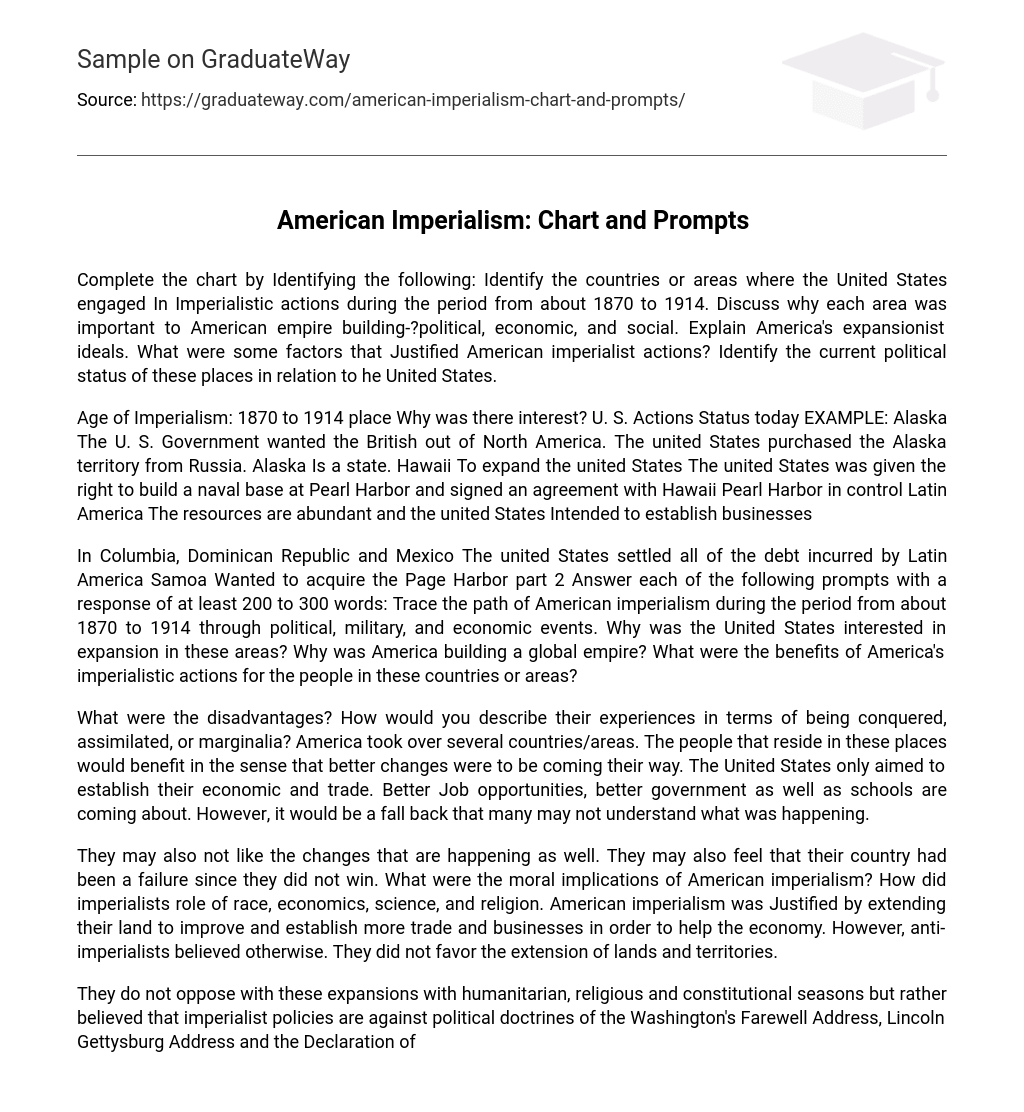During the years 1870 to 1914, the United States engaged in imperialistic actions across various countries or regions that held political, economic, or social significance for American empire building. This period reflected America’s expansionist ideals and was supported by multiple factors. It is important to acknowledge the present political status of these places in relation to the United States.
The Age of Imperialism, which took place from 1870 to 1914, was driven by U.S. actions. Currently, imperialism can be observed in various examples:
- One instance is Alaska:
- The U.S. Government aimed to remove the British from North America.
- In pursuit of this goal, the United States purchased Alaska territory from Russia.
- Consequently, Alaska is now a state.
- Another example is Hawaii:
- The United States sought to expand its territory.
- To achieve this, they were granted the right to construct a naval base at Pearl Harbor and made an agreement with Hawaii.
- Last but not least is Latin America:
- The resources in Latin America were abundant and the United States intended to establish businesses there.
-
In Latin America, specifically in Colombia, the Dominican Republic, and Mexico, the United States took on the responsibility of repaying all the debt accumulated by these countries. In American Samoa, there was a desire to acquire Page Harbor, which added another dimension to this ongoing situation. From 1870 to 1914, we can see the progression of American imperialism through political, military, and economic events. The United States had a strong interest in expanding its influence in various regions and pursued this objective using different approaches. Politically, they aimed to establish or manipulate governments that would align with their interests and ideologies. Militarily, they utilized their military power to intervene in conflicts or exert control over territories. Economically speaking, American companies made significant investments in foreign markets and industries while often exploiting local resources and labor.The motivations for American expansion were diverse. One of the main reasons was the belief in Manifest Destiny, which held that Americans had the destiny and right to spread their values and institutions not only across their continent but also beyond it. Another driving force was the desire for access to new markets for American goods and resources that could support industrial growth. The acquisition of territories also provided strategic military advantages for the United States.
However, it is important to note that American imperialism often failed to benefit the people in affected countries or areas. Many Latin American nations experienced economic exploitation and political instability as a result of American interventions. US companies perpetuated unfair labor practices and social injustices, leading to hardships for local populations. In essence, America’s imperialistic actions prioritized its own interests rather than promoting benefits for the inhabitants of these regions or countries.
What were the downsides and how can we characterize the experiences of being conquered, assimilated, or marginalized? The United States assumed control over multiple nations/regions. The individuals living there would profit from the anticipation of positive changes. The primary intention of the United States was to enhance their economic and trade relations. Improved job prospects, governance, and educational institutions were set to be established. Nonetheless, it was a drawback that numerous individuals might not comprehend the events taking place.
Additionally, they may not be fond of the ongoing changes. They might also perceive their country as a failure due to not emerging victorious. The moral implications of American imperialism and how race, economics, science, and religion played a role were topics of interest. American imperialism was justified through expanding their territory to enhance trade and foster economic growth. Conversely, anti-imperialists held contrasting beliefs, opposing the acquisition of new lands and territories.
The expansions are not opposed due to humanitarian, religious, and constitutional grounds; rather, they are seen as conflicting with the political ideals expressed in Washington’s Farewell Address, Lincoln’s Gettysburg Address, and the Declaration of Independence. The Spanish-American War played a pivotal role in America’s rise as an empire and global power. As a result of the war, the United States acquired control over Spanish territories such as the Philippines and Puerto Rico.
Despite the end of the Spanish empire, the American empire sought to strengthen and assist these colonies for trade and economic development. Do you think that the United States is currently an imperialist nation? Personally, I hold a differing viewpoint. Their intention was never to acquire additional territories but instead establish trade connections. Moreover, when employing military interventions, the United States only did so to protect its own country.
Support is only given to wars that are in self-defense. In World War I, the United States decided against acquiring territories and instead helped Germany and Japan with their post-war reconstruction. They also extended assistance to Korea and Vietnam during their respective conflicts. In Afghanistan, they fought and provided aid until it became unnecessary. It is crucial to properly cite and reference all sources of information according to the guidelines outlined in the Associate Level Writing Style Handbook.





